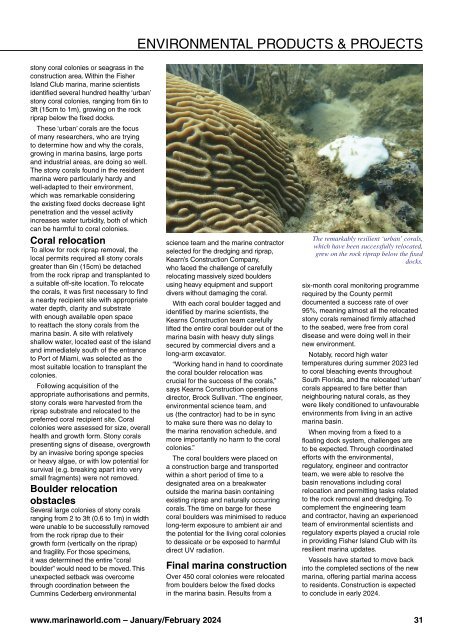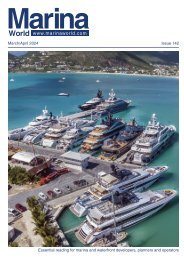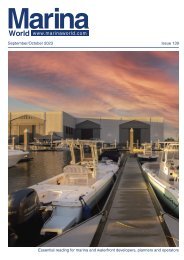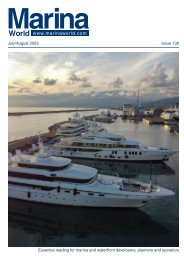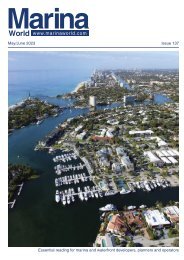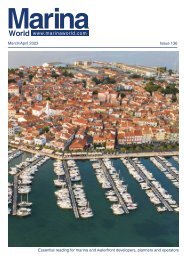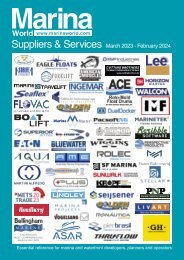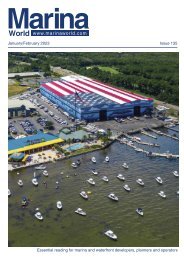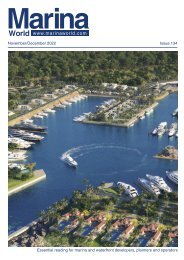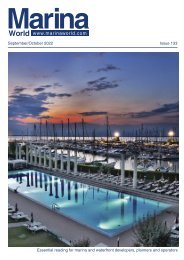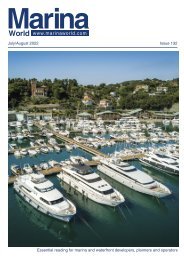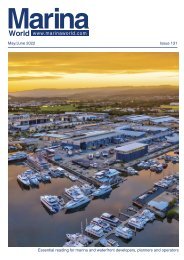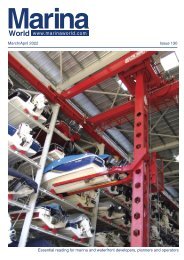2024 January/February Marina World
The magazine for the marina industry
The magazine for the marina industry
You also want an ePaper? Increase the reach of your titles
YUMPU automatically turns print PDFs into web optimized ePapers that Google loves.
ENVIRONMENTAL PRODUCTS & PROJECTS<br />
stony coral colonies or seagrass in the<br />
construction area. Within the Fisher<br />
Island Club marina, marine scientists<br />
identified several hundred healthy ‘urban’<br />
stony coral colonies, ranging from 6in to<br />
3ft (15cm to 1m), growing on the rock<br />
riprap below the fixed docks.<br />
These ‘urban’ corals are the focus<br />
of many researchers, who are trying<br />
to determine how and why the corals,<br />
growing in marina basins, large ports<br />
and industrial areas, are doing so well.<br />
The stony corals found in the resident<br />
marina were particularly hardy and<br />
well-adapted to their environment,<br />
which was remarkable considering<br />
the existing fixed docks decrease light<br />
penetration and the vessel activity<br />
increases water turbidity, both of which<br />
can be harmful to coral colonies.<br />
Coral relocation<br />
To allow for rock riprap removal, the<br />
local permits required all stony corals<br />
greater than 6in (15cm) be detached<br />
from the rock riprap and transplanted to<br />
a suitable off-site location. To relocate<br />
the corals, it was first necessary to find<br />
a nearby recipient site with appropriate<br />
water depth, clarity and substrate<br />
with enough available open space<br />
to reattach the stony corals from the<br />
marina basin. A site with relatively<br />
shallow water, located east of the island<br />
and immediately south of the entrance<br />
to Port of Miami, was selected as the<br />
most suitable location to transplant the<br />
colonies.<br />
Following acquisition of the<br />
appropriate authorisations and permits,<br />
stony corals were harvested from the<br />
riprap substrate and relocated to the<br />
preferred coral recipient site. Coral<br />
colonies were assessed for size, overall<br />
health and growth form. Stony corals<br />
presenting signs of disease, overgrowth<br />
by an invasive boring sponge species<br />
or heavy algae, or with low potential for<br />
survival (e.g. breaking apart into very<br />
small fragments) were not removed.<br />
Boulder relocation<br />
obstacles<br />
Several large colonies of stony corals<br />
ranging from 2 to 3ft (0.6 to 1m) in width<br />
were unable to be successfully removed<br />
from the rock riprap due to their<br />
growth form (vertically on the riprap)<br />
and fragility. For those specimens,<br />
it was determined the entire “coral<br />
boulder” would need to be moved. This<br />
unexpected setback was overcome<br />
through coordination between the<br />
Cummins Cederberg environmental<br />
science team and the marine contractor<br />
selected for the dredging and riprap,<br />
Kearn’s Construction Company,<br />
who faced the challenge of carefully<br />
relocating massively sized boulders<br />
using heavy equipment and support<br />
divers without damaging the coral.<br />
With each coral boulder tagged and<br />
identified by marine scientists, the<br />
Kearns Construction team carefully<br />
lifted the entire coral boulder out of the<br />
marina basin with heavy duty slings<br />
secured by commercial divers and a<br />
long-arm excavator.<br />
“Working hand in hand to coordinate<br />
the coral boulder relocation was<br />
crucial for the success of the corals,”<br />
says Kearns Construction operations<br />
director, Brock Sullivan. “The engineer,<br />
environmental science team, and<br />
us (the contractor) had to be in sync<br />
to make sure there was no delay to<br />
the marina renovation schedule, and<br />
more importantly no harm to the coral<br />
colonies.”<br />
The coral boulders were placed on<br />
a construction barge and transported<br />
within a short period of time to a<br />
designated area on a breakwater<br />
outside the marina basin containing<br />
existing riprap and naturally occurring<br />
corals. The time on barge for these<br />
coral boulders was minimised to reduce<br />
long-term exposure to ambient air and<br />
the potential for the living coral colonies<br />
to dessicate or be exposed to harmful<br />
direct UV radiation.<br />
Final marina construction<br />
Over 450 coral colonies were relocated<br />
from boulders below the fixed docks<br />
in the marina basin. Results from a<br />
The remarkably resilient ‘urban’ corals,<br />
which have been successfully relocated,<br />
grew on the rock riprap below the fixed<br />
docks.<br />
six-month coral monitoring programme<br />
required by the County permit<br />
documented a success rate of over<br />
95%, meaning almost all the relocated<br />
stony corals remained firmly attached<br />
to the seabed, were free from coral<br />
disease and were doing well in their<br />
new environment.<br />
Notably, record high water<br />
temperatures during summer 2023 led<br />
to coral bleaching events throughout<br />
South Florida, and the relocated ‘urban’<br />
corals appeared to fare better than<br />
neighbouring natural corals, as they<br />
were likely conditioned to unfavourable<br />
environments from living in an active<br />
marina basin.<br />
When moving from a fixed to a<br />
floating dock system, challenges are<br />
to be expected. Through coordinated<br />
efforts with the environmental,<br />
regulatory, engineer and contractor<br />
team, we were able to resolve the<br />
basin renovations including coral<br />
relocation and permitting tasks related<br />
to the rock removal and dredging. To<br />
complement the engineering team<br />
and contractor, having an experienced<br />
team of environmental scientists and<br />
regulatory experts played a crucial role<br />
in providing Fisher Island Club with its<br />
resilient marina updates.<br />
Vessels have started to move back<br />
into the completed sections of the new<br />
marina, offering partial marina access<br />
to residents. Construction is expected<br />
to conclude in early <strong>2024</strong>.<br />
www.marinaworld.com – <strong>January</strong>/<strong>February</strong> <strong>2024</strong><br />
31


